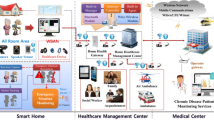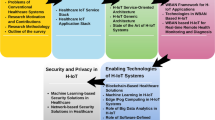Abstract
Purpose
Surgical workflow management in integrated operating rooms (ORs) enables the implementation of novel computer-aided surgical assistance and new applications in process automation, situation awareness, and decision support. The context-sensitive configuration and orchestration of interoperable, networked medical devices is a prerequisite for an effective reduction in the surgeons’ workload, by providing the right service and right information at the right time. The information about the surgical situation must be described as surgical process models and distributed to the medical devices and IT systems in the OR. Available modeling languages are not capable of describing surgical processes for this application.
Methods
In this work, the BPMNSIX modeling language for intraoperative processes is technically enhanced and implemented for workflow build-time and run-time. Therefore, particular attention is given to the integration of the recently published IEEE 11073 SDC standard family for a service-oriented architecture of networked medical devices. In addition, interaction patterns for context-aware configuration and device orchestration were presented.
Results
The identified interaction patterns were implemented in BPMNSIX for an ophthalmologic use case. Therefore, the examples of the process-driven incorporation and control of device services could be demonstrated.
Conclusion
The modeling of surgical procedures with BPMNSIX allows the implementation of context-sensitive surgical assistance functionalities and enables flexibility in terms of the orchestration of dynamically changing device ensembles and integration of unknown devices in the surgical workflow management.








Similar content being viewed by others
References
Reichert M (2011) What BPM technology can do for healthcare process support. In: Peleg M, Lavrac N, Combi C (eds) Artificial intelligence in medicine. Springer, Berlin, pp 2–13
Rotter T, Kinsman L, James EL, Machotta A, Gothe H, Willis J, Snow P, Kugler J (2010) Clinical pathways: effects on professional practice, patient outcomes, length of stay and hospital costs. Cochrane Database Syst Rev 3:CD006632
Sutherland J, van den Heuvel W (2006) Towards an intelligent hospital environment: adaptive workflow in the OR of the future. In: System Sciences, IEEE HICSS’06, pp 100b–100b
Feussner H, Ostler D, Kranzfelder M, Kohn N, Koller S, Wilhelm D, Thuemmler C, Schneider A (2017) Surgery 4.0. Health 4.0: how virtualization and big data are revolutionizing healthcare. Springer, Berlin, pp 91–107
OR.NET—Sichere dynamische Vernetzung in Operationsaal und Klinik. http://www.ornet.org/. Accessed 03 Jan 2019
Arney D, Pajic M, Goldman JM, Lee I, Mangharam R, Sokolsky O (2010) Toward patient safety in closed-loop medical device systems. In: ACM/IEEE international conference on cyber-physical systems, pp 139–148
Okamoto J, Masamune K, Iseki H, Muragaki Y (2018) Development concepts of a smart cyber operating theater (SCOT) using ORiN technology. Biomed Eng Biomed Tech 63:31–37
Franke S, Liebmann P, Neumuth T (2012) Connecting workflow management to the OR network: design and evaluation of a bridge to enable dynamic systems behaviour. Biomed Eng Biomed Tech 57:771–774
Franke S, Rockstroh M, Hofer M, Neumuth T (2018) The intelligent OR: design and validation of a context-aware surgical working environment. Int J Comput Assist Radiol Surg 13:1–8
Franke S, Neumuth T (2015) Rule-based medical device adaptation for the digital operating room. IEEE EMBC 2015:1733–1736
Neumann J, Vinz S, Neumuth T (2015) Surgical workflow and process modeling—an evaluation of modeling languages and process modeling tools. In: MICCAI 2015, M2CAI
Neumann J, Rockstroh M, Franke S, Neumuth T (2016) BPMNSIX—a BPMN 2.0 surgical intervention extension. In: MICCAI 2016, M2CAI
OMG (2016) DMN—decision model and notation (v. 1.1.). http://www.omg.org/spec/DMN/. Accessed 03 Jan 2019
Kasparick M, Schlichting S, Golatowski F, Timmermann D (2015) New IEEE 11073 standards for interoperable, networked point-of-care medical devices. IEEE EMBC 2016:1721–1724
Kasparick M, Schmitz M, Andersen B, Rockstroh M, Franke S, Schlichting S, Golatowski F, Timmermann D (2018) OR.NET: a service-oriented architecture for safe and dynamic medical device interoperability. Biomed Eng Biomed Tech 63(1):11–30
Andersen B, Kasparick M, Ulrich H, Franke S, Schlamelcher J, Rockstroh M, Ingenerf J (2018) Connecting the clinical IT infrastructure to a service-oriented architecture of medical devices. Biomed Eng Biomed Tech 63:57–68
Andersen B, Kasparick M, Golatowski F, Ingenerf J (2016) Extending the IEEE 11073-1010X nomenclature for the modelling of surgical devices. In: 2016 IEEE-EMBS, BHI, pp 244–247
Andersen B, Kasparick M, Baumhof S, Golatowski F, Ingenerf J (2016) Definition and validation of surgical device specialisations for a service-oriented medical device architecture. In: EMBC 2016
Kasparick M, Schlichting S, Golatowski F, Timmermann D (2015) Medical DPWS: new IEEE 11073 standard for safe and interoperable medical device communication. In: IEEE conference on standards for communications and networking (CSCN), pp 212–217
Neumuth T, Jannin P, Strauss G, Meixensberger J, Burgert O (2009) Validation of knowledge acquisition for surgical process models. J Am Med Inform Assoc JAMIA 16:72–80
MacKenzie CL, Ibbotson JA, Cao CGL, Lomax AJ (2001) Hierarchical decomposition of laparoscopic surgery: a human factors approach to investigating the operating room environment. Minim Invasive Ther Allied Technol 10:121–127
Neumuth T, Strauß G, Meixensberger J, Lemke HU, Burgert O (2006) Acquisition of process descriptions from surgical interventions. In: Bressan S, Küng J, Wagner R (eds) Database and expert systems applications. Springer, Berlin, pp 602–611
Katić D, Julliard C, Wekerle A-L, Kenngott H, Müller-Stich BP, Dillmann R, Speidel S, Jannin P, Gibaud B (2015) LapOntoSPM: an ontology for laparoscopic surgeries and its application to surgical phase recognition. Int J Comput Assist Radiol Surg 10(9):1427–1434
Padoy N, Blum T, Ahmadi S-A, Feussner H, Berger M-O, Navab N (2012) Statistical modeling and recognition of surgical workflow. Med Image Anal 16:632–641
Neumuth T, Durstewitz N, Fischer M, Strauss G, Dietz A, Meixensberger J, Jannin P, Cleary K, Lemke HU, Burgert O (2006) Structured recording of intraoperative surgical workflows. In: SPIE 6145, medical imaging 2006: PACS and imaging informatics, pp 61450A–61450A–12
OMG (2011) Business process model and notation: BPMN 2.0 specification http://www.omg.org/spec/BPMN/2.0/. Accessed 03 Jan 2019
Braun R, Schlieter H, Burwitz M, Esswein W (2014) BPMN4CP: design and implementation of a BPMN extension for clinical pathways. In: 2014 IEEE BIBM, pp 9–16
Betke H, Seifert M (2017) BPMN for disaster response processes. In: INFORMATIK 2017
Neumann J, Wiemuth M, Burgert O, Neumuth T (2017) Application of activity semantics and BPMN 2.0 in the generation and modeling of generic surgical process models. CARS 2017:S48–S49
Wiemuth M, Junger D, Leitritz MA, Neumann J, Neumuth T, Burgert O (2017) Application fields for the new Object Management Group (OMG) Standards Case Management Model and Notation (CMMN) and Decision Management Notation (DMN) in the perioperative field. Int J Comput Assist Radiol Surg 12:1439–1449
Hollingsworth D, Hampshire U (1995) Workflow management coalition: The workflow reference model. Doc Number TC00-1003 19
Funding
The work has been partially funded by the German Federal Ministry of Education and Research (Bundesministerium für Bildung und Foschung (BMBF)) under Reference No. 03VNE1036 as part of the MoVE project.
Author information
Authors and Affiliations
Corresponding author
Ethics declarations
Conflict of interest
The authors declare that they have no conflict of interest.
Informed consent
Informed consent was obtained from all individual participants included in the study.
Ethical standards
All procedures involving human participants have been approved and performed in accordance with ethical standards.
Additional information
Publisher's Note
Springer Nature remains neutral with regard to jurisdictional claims in published maps and institutional affiliations.
Rights and permissions
About this article
Cite this article
Neumann, J., Franke, S., Rockstroh, M. et al. Extending BPMN 2.0 for intraoperative workflow modeling with IEEE 11073 SDC for description and orchestration of interoperable, networked medical devices. Int J CARS 14, 1403–1413 (2019). https://doi.org/10.1007/s11548-019-01982-6
Received:
Accepted:
Published:
Issue Date:
DOI: https://doi.org/10.1007/s11548-019-01982-6




